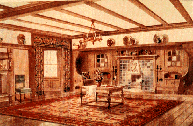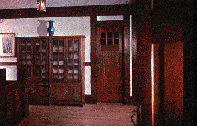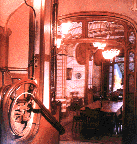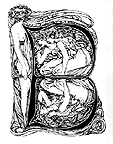

 This movement, which challenged the tastes of the Victorian era, was inspired
by the social reform concerns of thinkers such as Walter Crane and
John
Ruskin, together with the ideals of reformer and designer,
William
Morris.
(This link will take you to a less visual site that provides
William
Morris historical background).
This movement, which challenged the tastes of the Victorian era, was inspired
by the social reform concerns of thinkers such as Walter Crane and
John
Ruskin, together with the ideals of reformer and designer,
William
Morris.
(This link will take you to a less visual site that provides
William
Morris historical background).
Their notions of good design were linked to their notions of
a good society. This was a vision of a society in which the worker was not brutalized
by the working conditions found in factories, but rather could take pride in
his craftsmanship and skill. The rise of a consumer class coincided with the
rise of manufactured consumer goods. In this period, manufactured goods were
often poor in design and quality.  Ruskin, Morris, and others proposed that it would be better for all if
individual craftsmanship could be revived-- the worker could then produce beautiful
objects that exhibited the result of fine craftsmanship, as opposed to the shoddy
products of mass production. Thus the goal was to create design that was...
" for the people and by the people, and a source of pleasure to the maker and
the user." Workers could produce beautiful objects that would enhance the lives
of ordinary people, and at the same time provide decent employment for the craftsman.
Ruskin, Morris, and others proposed that it would be better for all if
individual craftsmanship could be revived-- the worker could then produce beautiful
objects that exhibited the result of fine craftsmanship, as opposed to the shoddy
products of mass production. Thus the goal was to create design that was...
" for the people and by the people, and a source of pleasure to the maker and
the user." Workers could produce beautiful objects that would enhance the lives
of ordinary people, and at the same time provide decent employment for the craftsman.
 Medieval Guilds provided a model for the ideal craft production system. Aesthetic
ideas were also borrowed from Medieval European and Islamic sources. Japanese
ideas were also incorporated early Arts and Crafts forms. The
forms of Arts and Crafts style were typically rectilinear and angular,
with stylized decorative motifs remeniscent of medieval and Islamic design.
In addition to William Morris,
Charles Voysey was
another important innovator in this style. One designer of this period, Owen
Jones, published a book entitled
The Grammar of Ornament, which was a
sourcebook of historic decorative design elements, largely taken from medieval
and Islamic sources. This work in turn inspired the use of such historic sources
by other designers.
Medieval Guilds provided a model for the ideal craft production system. Aesthetic
ideas were also borrowed from Medieval European and Islamic sources. Japanese
ideas were also incorporated early Arts and Crafts forms. The
forms of Arts and Crafts style were typically rectilinear and angular,
with stylized decorative motifs remeniscent of medieval and Islamic design.
In addition to William Morris,
Charles Voysey was
another important innovator in this style. One designer of this period, Owen
Jones, published a book entitled
The Grammar of Ornament, which was a
sourcebook of historic decorative design elements, largely taken from medieval
and Islamic sources. This work in turn inspired the use of such historic sources
by other designers.
 However,in time the English Arts and Crafts movement came to stress craftsmanship
at the expense of mass market pricing. The result was exquisitely made and decorated
pieces that could only be afforded by the very wealthy. Thus the idea of art
for the people was lost, and only relatively few craftsman could be employed
making these fine pieces. This evolved English Arts and Crafts style came to
be known as "Aesthetic Style." It shared some characteristics
with the French/Belgian Art Nouveau movement, to be discussed below.
However,in time the English Arts and Crafts movement came to stress craftsmanship
at the expense of mass market pricing. The result was exquisitely made and decorated
pieces that could only be afforded by the very wealthy. Thus the idea of art
for the people was lost, and only relatively few craftsman could be employed
making these fine pieces. This evolved English Arts and Crafts style came to
be known as "Aesthetic Style." It shared some characteristics
with the French/Belgian Art Nouveau movement, to be discussed below.
However in the United States, the Arts and Crafts ideal of design for the
masses was more fully realized, though at the expense of the fine
individualized craftsmanship typical of the English style. In New York,
Gustav
Stickley was trying to serve a burgeoning market of middle class consumers who
wanted affordable, decent looking furniture. By using factory methods to
produce basic components, and utilizing craftsmen to finish and assemble, he
was able to produce sturdy, serviceable furniture which was sold in vast
quantities, and still survives. The rectilinear, simpler
American Arts and Crafts forms came to dominate American architecture, interiors,
and furnishings in the late nineteenth and early twentieth century.
 Today Stickley's furniture is prized by collectors, and the
Stickley Company
still exists, producing reproductions of the original Stickley designs.
Today Stickley's furniture is prized by collectors, and the
Stickley Company
still exists, producing reproductions of the original Stickley designs.
 The term Mission style was also used to describe Arts and Crafts
Furniture and design in the United States. The use of this term reflects the
influence of traditional furnishings and interiors from the American Southwest,
which had many features in common with the earlier British Arts and Crafts forms.
Charles and Henry Greene
were important Mission style architects working in California. Southwestern
style also incorporated Hispanic elements associated with the early Mission
and Spanish architecture, and Native American design. The result was a blending
of the arts and crafts rectilinear forms with traditional Spanish colonial architecture
and furnishings. Mission Style interiors were often embellished with Native
American patterns, or actual Southwestern Native American artifacts such as
rugs, pottery, and baskets. The collecting of Southwestern artifacts became
very popular in the first quarter of the twentieth century.
The term Mission style was also used to describe Arts and Crafts
Furniture and design in the United States. The use of this term reflects the
influence of traditional furnishings and interiors from the American Southwest,
which had many features in common with the earlier British Arts and Crafts forms.
Charles and Henry Greene
were important Mission style architects working in California. Southwestern
style also incorporated Hispanic elements associated with the early Mission
and Spanish architecture, and Native American design. The result was a blending
of the arts and crafts rectilinear forms with traditional Spanish colonial architecture
and furnishings. Mission Style interiors were often embellished with Native
American patterns, or actual Southwestern Native American artifacts such as
rugs, pottery, and baskets. The collecting of Southwestern artifacts became
very popular in the first quarter of the twentieth century.
 This style, which was more or less concurrent with the Arts and Crafts style,
was not at all concerned with the social reform movements of the day. Instead,
it addressed the clutter and eclecticism of mid-19th century European taste. Originating
in Belgium and France, this movement advocated nature as the true source of all
good design. Art Nouveau designers objected to the borrowing of design ideas from
the past, and even from other cultures, although the Japanese approach to nature
was much admired and emulated.
This style, which was more or less concurrent with the Arts and Crafts style,
was not at all concerned with the social reform movements of the day. Instead,
it addressed the clutter and eclecticism of mid-19th century European taste. Originating
in Belgium and France, this movement advocated nature as the true source of all
good design. Art Nouveau designers objected to the borrowing of design ideas from
the past, and even from other cultures, although the Japanese approach to nature
was much admired and emulated.
 The characteristics of the style included above all the use of the sinuous curved
line, together with asymmetrical arrangement of forms and patterns. The forms
from nature most popular with Art Nouveau designers were characterized by flowing
curves-- grasses, lilies, vines, and the like. Other, more unusual natural forms
were also used, such as peacock feathers, butterflies, and insects.
The characteristics of the style included above all the use of the sinuous curved
line, together with asymmetrical arrangement of forms and patterns. The forms
from nature most popular with Art Nouveau designers were characterized by flowing
curves-- grasses, lilies, vines, and the like. Other, more unusual natural forms
were also used, such as peacock feathers, butterflies, and insects.
Architects and designers who contributed to the development of this style
included Victor Horta
,
Hector Guimard (Click on Buildings and Subway in TOC on left),
and
Henry van de Velde.
The
glass and
jewelry design of Lalique,
as well as the stained glass and other designs of
Louis Comfort Tiffany
and
Emile Galle (nice video at bottom of page)
were important examples of Art Nouveau style.
 A distinctive graphic design style developed, which included typography styles
as well as a distinctive manner of drawing the female figure. The prints of
Aubrey Beardsley
and
Alphonse Mucha are typical of this style.
A distinctive graphic design style developed, which included typography styles
as well as a distinctive manner of drawing the female figure. The prints of
Aubrey Beardsley
and
Alphonse Mucha are typical of this style.
For additional
Art Nouveau images and information, try this link.
 |